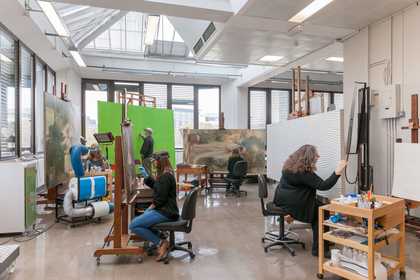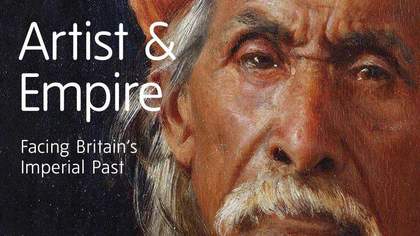Completed in 1874, The North-West Passage was one of the most popular works of its time; a number of high profile Arctic explorations took place during the 19th century, and through the depiction of the aged mariner, sitting defiantly at his table surrounded by maps, charts and flags, and of his daughter, reading through past log books, Millais wanted to convey and inspire patriotic sentiment. Â
Henry Tate bought the painting in 1888, and if formed part of the original Henry Tate bequest, entering the national collection in 1894. Since then, the work has been on regular loan and display, and can currently be viewed in the Tate Britain exhibition Artist and Empire.
The painting was made on two commercially primed canvases joined together with glue paste. The paint layers are composed of oil and use a range of typical 19th century pigments; it is most likely the paints were purchased ready-mixed from artists’ suppliers called colourmen who were becoming more established throughout this period. When painting, Millais initially laid down thin layers of relatively dry paint over the white-coloured ground-layer; he then used paint with more body to build the image up in layers using a broad, painterly technique of application. In a few places he rubbed back the paint to expose the under-layers and emphasise the weave pattern of the canvas. Millais frequently experimented with his materials, adding other mediums to his paint to try and alter and improve both the quality of the pigment and the translucency of the paint. Scientific analysis shows that there are at least four layers of paint in the black coat, and each one has been modified by Millais who has added varying quantities of megilp or resin. The artist’s monogram and the date are painted in red paint in the bottom right corner, and at least three layers of varnish are present.

Female figure from The North-West Passage after cleaning; note the pink ribbon in the dress which has been obscured by the discoloured varnish.Â
© Tate PhotographyÂ
Preparatory sketches show that a number of compositions were trialled before settling on the current image. During the execution of the painting, Millais worked energetically, making continual alterations to the composition. The art critic, Sir John Forbes-Robertson wrote “he was on springs all the time, he literally rushed at the canvas, made some correction, then back again several yards from the easel. He seemed longer from the picture than at it, but the work was not slow in growing”.Â
Changes to the composition are evident in a number of ways: Millais is known to have cut off and discarded the top right quarter of the canvas during painting. Two children were originally depicted in this corner, and when Millais decided to remove them, he cut away and removed the canvas. In his book The Life and Letters of Sir John Millais, J.G.Millais, the artist’s son, wrote:
After the background and the two central figures were finished, my sister Alice and myself were called in to represent two children turning over a globe, in the right hand corner, and every day for about a fortnight did we turn that wretched globe till we hated the sight of it. All to no purpose, too, for it was found at last that our figures spoilt the composition and marred the simplicity of the tale. So out we went, that part of the canvas was cut away, and a new piece deftly inserted.
The discarded piece of canvas was kept and reworked at a later date, forming the basis for the painting 1874. The mention of a globe, however, is insightful, as an X-radiograph taken of the painting clearly shows the location of a large globe, not in the top right, but in the bottom left corner of the painting. This was then painted over and replaced with a table, glass and telescope.Â
It is interesting to note that the segment of canvas which was used to replace the cut away piece was probably an off-cut from another painting. In the X-ray, heavily worked paint-strokes, possibly forming a landscape or seascape are visible in this section. Other changes visible on the X-ray include the altered position of the chair back and legs, and the covering up of possible drapery to the right of the seated female (this may relate to the standing position of the cut-away female child). Another unaccountable area is the painterly halo behind the female’s head. This is unrelated to the map in the final image, and is not seen in any of the preparatory drawings. It may be covering up further unwanted details below, or Millais may have laid down a large white under-layer on which to paint the map. The male figure’s face is also unusual in its heavy re-working, especially when compared to that of the female figure which appears to have been executed in one sitting with little or no reworking. It is also interesting to note that the female head may contain zinc white pigments and not the more traditionally used lead white (as in the head of the man). There have also been alterations to the background behind the male’s head, which indicate that a different art work hung on the wall prior to the painting of the Nelson print. The number of alterations reinforces documentation of the time which notes the energetic and spontaneous manner of Millais’s working.
Prior to Artist and Empire, the curators listed the work as being a priority for varnish removal. The patchy varnish-layers were not only yellowed and discoloured, but were also starting to go opaque in places. The overall effect deadened the colours of the original work making the light colours appear darker and warmer in tonality, and the dark colours appear lighter. Because this disrupted the tonal balance of the painting and reduced the illusion of depth, it was decided that, if safe to do so, the varnish-layers should be removed. Â
Tests were carried out using a variety of solvents and over the course of a few months, the varnish layers were removed. In places the resinous material in the paint proved difficult to clean over, and so the varnish was thinned in these areas. Generous funding from the Tate patrons allowed this conservation to be undertaken; the treatment was successful and significantly improved the aesthetic appearance of the painting.
See more works by Millais in the °Ő˛ąłŮ±đĚý°ä´Ç±ô±ô±đł¦łŮľ±´Ç˛Ô
Join the conversationÂ


